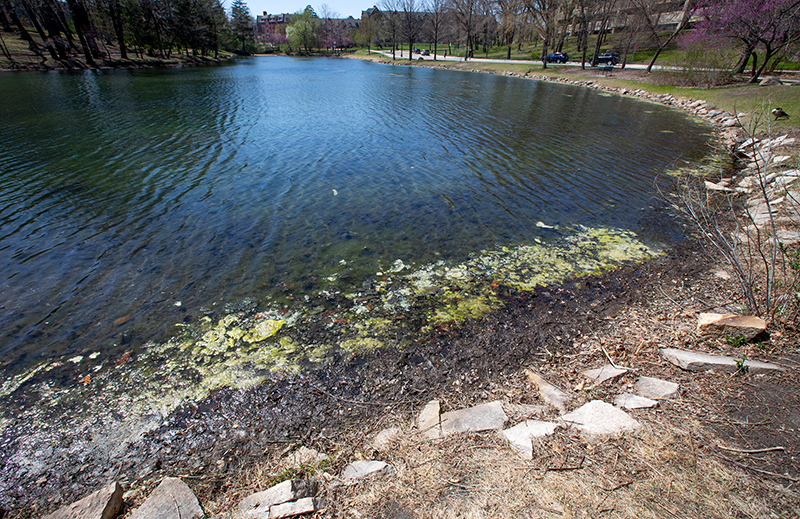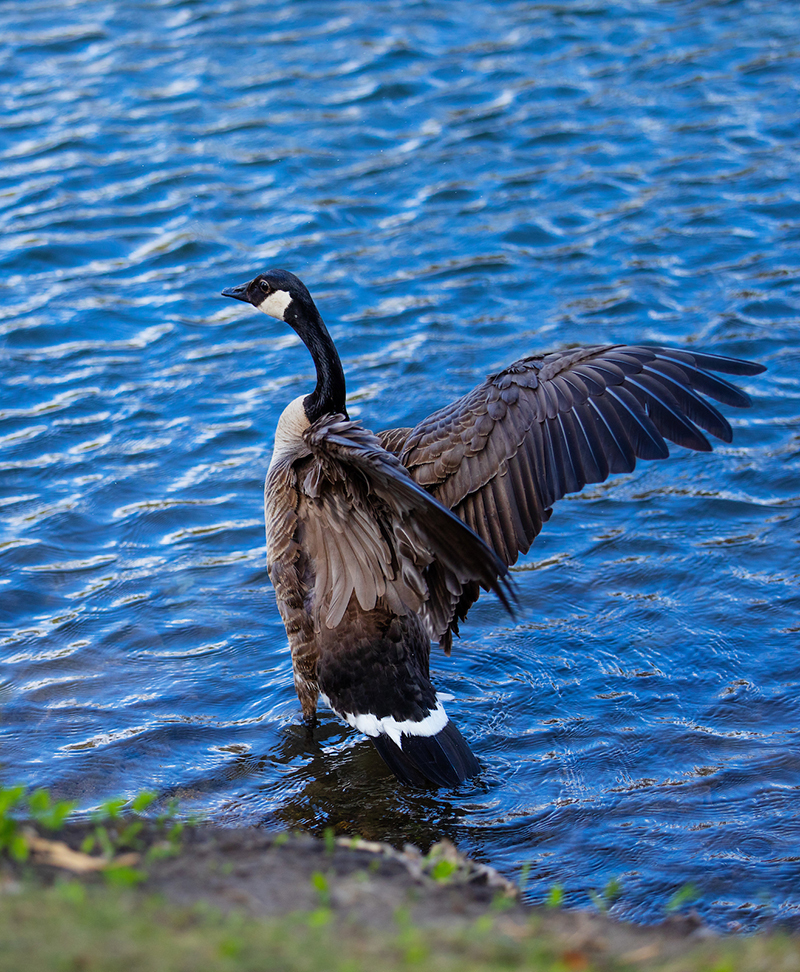
Draining and mechanically removing several feet of bottom sediment from Lake LaVerne would address two issues: shallow water depths and phosphorus levels in the water. Photos by Christopher Gannon.
Design work begins this spring on a plan to restore and improve Lake LaVerne. The project would remove decades of bottom sediment to increase water depth, stabilize the erosion-prone shoreline and address the areas immediately surrounding the lake, where runoff is a contributor to water quality. The restoration also would address some infrastructure needs, including improvements to the concrete outlet in the southeast corner and safety improvements along the gravel path south of the lake.
Consultants from Shive-Hattery will follow up with the design phase. They were on the team that completed a six-month study of the lake in 2022, mapping water and sediment depths and analyzing water samples. President Wendy Wintersteen reviewed the report from that study and greenlighted the design phase, which will take four to five months and cost about $125,000. Donor funds will cover the design phase.
Lake management plan
Physical improvements aren't the only change coming. Campus planner Chris Strawhacker, facilities planning and management, who coordinated the 2022 lake study, said a university team of faculty, researchers and FPM professionals will be assembled to systematically assess the lake and recommend actions as issues arise. With expertise in areas such as water quality, plant habitat and wildlife, the team would develop an adaptive management plan to elevate and maintain the quality and functionality of the lake. Faculty members from the group also assisted with the 2022 study and will be involved in the lake restoration design as needed.
A lake by name
Strawhacker emphasized that the intent of the restoration -- and the management plan -- is to maintain campus aesthetics and steward a 100-plus-year-old campus icon. It's not about creating a recreational hot spot for fishing or swimming.
Yes, swans will be back
Campus planner Chris Strawhacker said a pair of swans, Lancelot and Elaine -- another Iowa State tradition going back to 1935 -- will return to Lake LaVerne. A new duo will arrive once the lake restoration is complete, though that project timeline isn't known yet.
"We want our Iowa State community to have realistic expectations about what Lake LaVerne could be following restoration," Strawhacker said. "For example, plant growth is important to a healthy lake ecosystem, so we'll always have aquatic plants and algae growing in the lake. But by making improvements, we can make this small ecosystem healthier and visually more appealing."
The lake and the swans who roam it are beloved university traditions with alumni and students -- and will be maintained, he said.
"We also think that a team of experts, meeting regularly to assess and discuss changes in the lake as they're occurring, will contribute to the long-term health of the water and the plants and animals in it," he added.
One misperception about Lake LaVerne may be where its water comes from. The lake isn't fed by a creek or underground spring, and it's not even a dammed stream anymore, which is how it originated in 1916. It relies on precipitation, a well near the southwest corner and roof runoff from two adjacent buildings for water.
Lake LaVerne was created with a $10,000 donation from LaVerne Noyes, an alumnus from Iowa State's first graduating class of 1872. A dam constructed on College Creek flooded a 2.5-acre marsh in what now is the east end of the lake. In the 1930s, the creek was separated from the lake and still runs in a mostly underground channel from Welch Road to the east side of the Memorial Union parking ramp. In the 1930s, 1950s and 1990s, the lake was dredged, but not drained. The university made other changes over the decades to try to manage the sediment and water nutrient levels, for example, reinforcing the north shoreline, preventing street stormwater from draining into it and adding multiple aerators.
Shrinking watershed
From a watershed perspective, the lake's evolution over more than a century has been dramatic, Strawhacker said. In 1916, the lake's watershed was about 2,000 acres. When College Creek flow bypassed the lake in the 1930s, the watershed shrunk to 35 acres. Currently, the lake's watershed is about eight acres.
"We see it as a lake, but it functions more like an aquarium, with a little inflow and very little outflow," he said. "That's part of our management challenge, and it's a unique one."
Highlights of the 2022 lake study

Reducing the impact of the not-so-migratory Canada geese will be a goal of an adaptive Lake LaVerne management plan.
Consultants from Shive-Hattery and Stanec concluded in the fall of 2022 that the two primary issues with Lake LaVerne are water quality and water depth -- on average, less than three feet -- due to decades of sediment buildup on the bottom. In fact, an estimated 43% of the lake's volume currently is a soft, pudding-like sediment, not water. The consultants recommended draining, then mechanically removing the sediment layer to restore the lake to original depths -- up to 12 feet in spots. Deeper water will improve water quality, they noted.
High levels of nutrients, mostly phosphorus, in both the lake water and bottom sediment boost algae and plant production, can deplete oxygen levels and create a toxic environment for fish and wildlife. Twice a year, FPM's campus services team treats the lake with aluminum sulfate, a chemical that suppresses phosphorus in water, cutting off the nutrient source for plants and algae and resulting in clearer water. Those semi-annual treatments are doing the job, according to the consultants. The spring alum treatment was completed April 11, and another is planned in the fall. Because it's a source of phosphorus, removing the bottom sediment also will improve water quality.
According to the consultants, the major sources for phosphorus entering the lake are sediment runoff, waterfowl waste and the well that pumps groundwater into Lake LaVerne. Deepening the lake will help decrease and dilute phosphorus levels. Ongoing lake management would address the well operation and variables such as waterfowl, primarily the Canada geese who reside there year-round, or the future of the aeration system installed in 1998 to maintain oxygen levels in the lake.
The consultants estimate that completing the components in the lake restoration plan would cost about $1 million. Fundraising will be the focus for implementing the plan.
Related stories
- Mute swan Elaine is retiring from Lake LaVerne, Nov. 17, 2022
- A very good reason Lake LaVerne looks a bit soupy, Aug. 25, 2002

